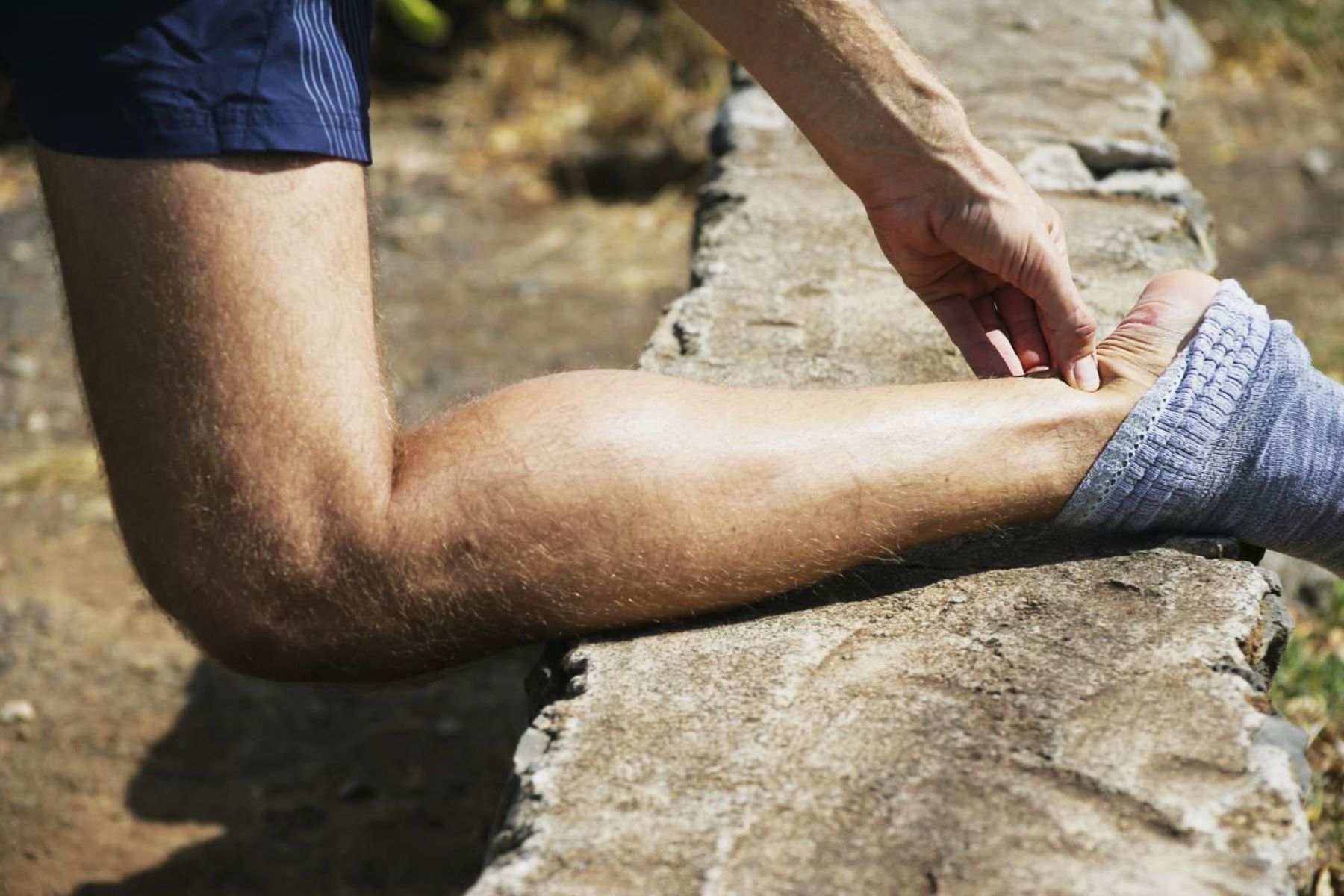Home>Health & Nutrition>Injury Prevention>What You Need To Know If You Suspect A Stress Fracture While Running


Injury Prevention
What You Need To Know If You Suspect A Stress Fracture While Running
Published: February 25, 2024
Learn how to recognize and manage a potential stress fracture while running. Discover essential tips for injury prevention to keep your running routine on track.
(Many of the links in this article redirect to a specific reviewed product. Your purchase of these products through affiliate links helps to generate commission for Therunningadvisor.com, at no extra cost. Learn more)
Table of Contents
Understanding stress fractures
Stress fractures are tiny cracks in a bone that commonly occur in weight-bearing bones, often as a result of repetitive force or overuse. These injuries are particularly prevalent among runners due to the repetitive impact of the activity. When the muscles become fatigued and are unable to absorb the stress of impact, the bones bear the brunt, leading to the development of stress fractures.
The most common sites for stress fractures in runners are the shinbone (tibia), the bones of the feet, and the heel. These fractures can also occur in the hip and pelvis, although less frequently. It's important to note that stress fractures can be challenging to detect through traditional imaging techniques like X-rays, especially in the early stages. In some cases, a bone scan or magnetic resonance imaging (MRI) may be necessary for an accurate diagnosis.
Understanding the nature of stress fractures is crucial for runners, as it can help them recognize the warning signs and take proactive measures to prevent further damage. It's essential to differentiate stress fractures from other running-related injuries, such as muscle strains or tendonitis, as the treatment and recovery process may vary significantly.
By gaining a deeper understanding of stress fractures, runners can make informed decisions about their training regimens, footwear choices, and running surfaces to minimize the risk of developing these debilitating injuries.
Read more: Running And Bunions: What You Need To Know
Signs and symptoms of a stress fracture
Identifying the signs and symptoms of a stress fracture is crucial for runners to address potential injuries promptly and prevent further damage. While these fractures can manifest differently for each individual, there are common indicators to watch for:
-
Localized Pain: One of the primary symptoms of a stress fracture is localized pain at the site of the injury. This discomfort typically worsens during weight-bearing activities and diminishes with rest. Runners may notice tenderness and swelling in the affected area, often accompanied by a dull or throbbing ache.
-
Pain During Activity: As the stress fracture progresses, runners may experience pain during physical activity, particularly while running or jumping. The discomfort may initially be mild and intermittent but can intensify over time, hindering performance and causing discomfort even during daily activities.
-
Pain at Rest: In advanced stages, the pain from a stress fracture may persist even at rest, disrupting sleep and impacting overall mobility. This persistent discomfort, especially when combined with localized tenderness, should prompt runners to seek medical evaluation.
-
Changes in Gait: Runners with stress fractures may unconsciously alter their gait to alleviate pressure on the affected area, leading to an irregular stride or favoring one leg over the other. These gait changes can contribute to additional strain on other muscles and joints, potentially exacerbating the injury.
-
Swelling and Bruising: In some cases, visible swelling and bruising may accompany a stress fracture. The affected area may appear inflamed and tender to the touch, indicating the body's inflammatory response to the bone injury.
-
Reduced Performance: As the pain and discomfort from a stress fracture escalate, runners may notice a decline in their performance and endurance. Tasks that were once routine, such as completing a specific distance or maintaining a certain pace, may become increasingly challenging.
Recognizing these signs and symptoms is pivotal for runners to differentiate a stress fracture from general muscle soreness or fatigue. Ignoring these indicators and continuing to push through the pain can exacerbate the injury, prolonging the recovery process and potentially leading to more severe complications. Therefore, it is essential for runners to prioritize their well-being and seek appropriate medical attention if they suspect a stress fracture.
Risk factors for developing a stress fracture
Several factors contribute to the development of stress fractures among runners, highlighting the multifaceted nature of these injuries. Understanding these risk factors is crucial for athletes to proactively mitigate the likelihood of sustaining such debilitating bone injuries.
Inadequate Footwear
Wearing worn-out or ill-fitting running shoes can significantly increase the risk of stress fractures. Shoes with insufficient cushioning or inadequate support fail to absorb the impact of each stride effectively, placing excessive stress on the bones and increasing the likelihood of developing fractures.
Training Errors
Rapidly increasing the intensity, duration, or frequency of running sessions without allowing the body sufficient time to adapt can lead to stress fractures. Failing to incorporate gradual progression and adequate rest periods into training regimens can overload the bones, making them more susceptible to injury.
Read more: What To Do If You Suspect An Ankle Sprain
Biomechanical Imbalances
Runners with biomechanical irregularities, such as overpronation (excessive inward rolling of the foot) or supination (outward rolling of the foot), are at a heightened risk of developing stress fractures. These imbalances can disrupt the distribution of impact forces, placing undue strain on specific bones and increasing the likelihood of fractures.
Nutritional Deficiencies
Inadequate intake of essential nutrients, particularly calcium and vitamin D, can compromise bone health and density, making runners more susceptible to stress fractures. Insufficient dietary support for bone remodeling and repair diminishes the bones' ability to withstand the repetitive stress of running.
Female Athlete Triad
Female runners are particularly vulnerable to stress fractures due to the interplay of disordered eating, menstrual irregularities, and decreased bone density, collectively known as the Female Athlete Triad. The hormonal imbalances associated with this condition can weaken the bones, heightening the risk of stress fractures.
Previous History of Stress Fractures
Athletes with a prior history of stress fractures are at an increased risk of experiencing recurrent injuries. Insufficient rehabilitation, premature return to high-impact activities, or neglecting to address underlying risk factors can predispose individuals to ongoing bone stress and subsequent fractures.
Read more: All You Need To Know About Strava Summit
Environmental Factors
Running on hard or uneven surfaces, such as concrete or uneven trails, can amplify the impact forces transmitted to the bones, increasing the risk of stress fractures. Additionally, sudden changes in running terrain or engaging in activities with repetitive impact, such as running downhill, can heighten the risk of bone injuries.
Muscle Weakness and Imbalance
Weakness or imbalance in the muscles that support and stabilize the lower limbs can contribute to altered biomechanics and increased stress on the bones. Inadequate strength in the muscles surrounding the hips, knees, and ankles can compromise the body's ability to absorb and distribute impact forces effectively, predisposing runners to stress fractures.
By recognizing these risk factors, runners can take proactive measures to mitigate their impact, such as investing in appropriate footwear, implementing gradual training progressions, addressing biomechanical imbalances through corrective exercises, prioritizing adequate nutrition, and incorporating strength training to enhance musculoskeletal resilience. These proactive steps are essential for minimizing the risk of stress fractures and promoting long-term running health and performance.
When to see a doctor
Recognizing the appropriate time to seek medical evaluation is pivotal for runners who suspect a stress fracture. Prompt intervention can facilitate timely diagnosis, prevent further exacerbation of the injury, and expedite the recovery process. While some individuals may attempt to self-manage the discomfort initially, certain indicators warrant immediate medical attention.
Persistent or Worsening Pain: If the localized pain associated with a suspected stress fracture persists or intensifies despite rest and reduced activity, it is imperative to consult a healthcare professional. Persistent discomfort, especially during weight-bearing activities or at rest, may signify an underlying bone injury that necessitates thorough evaluation.
Visible Swelling and Bruising: The presence of visible swelling, inflammation, or bruising around the affected area is a compelling reason to seek medical assessment. These signs indicate an inflammatory response and potential damage to the bone, warranting expert evaluation to determine the extent of the injury and formulate an appropriate treatment plan.
Altered Gait and Mobility: Runners who notice significant alterations in their gait, such as limping or favoring one leg over the other, should prioritize a medical consultation. Changes in mobility patterns often indicate an attempt to alleviate pressure on the injured area, signifying the need for professional assessment to prevent further musculoskeletal complications.
Impact on Daily Activities: When the discomfort from a suspected stress fracture begins to impede daily activities and disrupts sleep or mobility, it is advisable to seek medical guidance. The inability to perform routine tasks or engage in physical activities without persistent pain warrants a comprehensive evaluation to address the underlying cause and facilitate effective management.
History of Stress Fractures: Individuals with a history of stress fractures or recurrent bone injuries should promptly consult a healthcare provider when experiencing similar symptoms. Previous bone injuries can predispose individuals to subsequent fractures, necessitating vigilant monitoring and timely intervention to prevent prolonged impairment and complications.
By recognizing these indicators and prioritizing timely medical assessment, runners can expedite the diagnostic process, receive appropriate treatment, and initiate targeted rehabilitation strategies. Seeking medical guidance at the onset of suspected stress fracture symptoms is instrumental in mitigating the impact of the injury and promoting efficient recovery, ultimately facilitating a safe return to running activities.
Treatment options for stress fractures
Upon diagnosis of a stress fracture, implementing appropriate treatment strategies is paramount to facilitate effective healing and prevent long-term complications. The management of stress fractures typically involves a comprehensive approach aimed at alleviating pain, promoting bone repair, and addressing contributing factors to prevent recurrence.
Rest and Activity Modification
Rest is a cornerstone of stress fracture management, as it allows the affected bone to heal without further stress or strain. Runners are advised to refrain from high-impact activities, including running and jumping, to prevent exacerbation of the injury. Engaging in non-weight-bearing exercises, such as swimming or cycling, can help maintain cardiovascular fitness while minimizing impact on the injured bone.
Immobilization
In some cases, immobilization through the use of a walking boot, cast, or crutches may be necessary to offload the affected bone and facilitate optimal healing. Immobilization reduces the mechanical stress on the fracture site, promoting alignment and stability during the initial phases of recovery.
Pain Management
Managing pain and inflammation is integral to the treatment of stress fractures. Nonsteroidal anti-inflammatory drugs (NSAIDs) or other pain-relieving medications may be prescribed to alleviate discomfort and reduce swelling. However, it is essential to use these medications under the guidance of a healthcare professional to minimize potential side effects and ensure compatibility with the healing process.
Orthotic Support
Custom orthotic devices or supportive footwear may be recommended to redistribute pressure and provide cushioning for the affected bone. These interventions aim to optimize biomechanics and reduce the impact forces transmitted to the injured area during weight-bearing activities.
Read more: All You Need To Know About Hamstring Strains
Physical Therapy
Physical therapy plays a crucial role in the rehabilitation of stress fractures. Therapeutic exercises focused on strengthening the muscles surrounding the affected bone, improving flexibility, and enhancing overall lower limb stability can aid in the gradual resumption of weight-bearing activities. Additionally, targeted rehabilitation programs address biomechanical imbalances and gait abnormalities to mitigate the risk of recurrent stress fractures.
Nutritional Support
Optimizing nutritional intake, particularly calcium, vitamin D, and other essential nutrients, is vital for bone health and fracture healing. Healthcare providers may recommend dietary modifications or supplements to support bone remodeling and enhance the mineralization of the healing bone.
Gradual Return to Running
Upon adequate healing and clearance from a healthcare professional, runners can gradually reintroduce running activities. A structured return-to-running program, incorporating progressive increases in mileage and intensity, allows the bone to adapt to impact forces while minimizing the risk of reinjury.
Monitoring and Follow-Up
Regular monitoring and follow-up appointments with healthcare providers are essential to assess the progression of healing, address any emerging concerns, and modify the treatment plan as needed. Ongoing evaluation facilitates the timely identification of potential complications and ensures that the recovery trajectory aligns with the expected outcomes.
By integrating these treatment options, runners can effectively navigate the recovery process, mitigate the impact of stress fractures, and cultivate strategies to prevent future injuries. The comprehensive approach to stress fracture management encompasses not only the physical healing of the bone but also the optimization of biomechanics, musculoskeletal resilience, and overall running health.
Read more: All You Need To Know About Hip Flexor Strain
Preventing stress fractures while running
Preventing stress fractures is paramount for runners seeking to sustain their passion for the sport while minimizing the risk of debilitating bone injuries. By implementing proactive measures and adopting a holistic approach to running health, athletes can significantly reduce the likelihood of developing stress fractures. Here are essential strategies to prevent stress fractures while running:
Gradual Training Progression
Gradual and progressive increases in training intensity, duration, and mileage allow the body to adapt to the demands of running, reducing the risk of overloading the bones and developing stress fractures. Incorporating structured training plans with incremental adjustments helps runners build endurance and strength while minimizing the impact of repetitive stress on the bones.
Proper Footwear Selection
Investing in high-quality running shoes that provide adequate cushioning, support, and stability is essential for mitigating the impact forces transmitted to the bones during running. Regularly replacing worn-out shoes and selecting footwear tailored to individual biomechanical needs can optimize shock absorption and reduce the strain on the lower limbs, thereby lowering the risk of stress fractures.
Surface Consideration
Choosing running surfaces that offer sufficient shock absorption, such as rubberized tracks or well-maintained trails, can minimize the repetitive impact on the bones. Avoiding hard or uneven surfaces, such as concrete or excessively rocky terrain, reduces the strain on the musculoskeletal system, contributing to a lower risk of stress fractures.
Read more: All You Need To Know About IT Band Syndrome
Cross-Training and Strength Conditioning
Incorporating cross-training activities, such as swimming, cycling, or strength training, diversifies the impact on the musculoskeletal system, reducing the repetitive stress on specific bones. Strengthening the muscles that support and stabilize the lower limbs enhances overall biomechanical resilience, diminishing the susceptibility to stress fractures.
Balanced Nutrition
Maintaining a balanced and nutrient-rich diet, particularly with adequate calcium, vitamin D, and other essential nutrients, supports bone health and resilience. Optimal nutrition facilitates bone remodeling and repair, fortifying the bones against the repetitive stress of running and reducing the likelihood of stress fractures.
Biomechanical Assessment and Correction
Undergoing a biomechanical assessment by a qualified professional can identify gait irregularities, foot pronation issues, or muscle imbalances that contribute to increased stress on specific bones. Implementing corrective measures, such as orthotic support or targeted exercises, can optimize biomechanics and reduce the risk of stress fractures.
Rest and Recovery
Prioritizing adequate rest and recovery periods between running sessions is crucial for allowing the bones and muscles to recuperate. Incorporating rest days, varying training intensity, and recognizing the signs of fatigue can prevent overuse injuries, including stress fractures, while promoting overall running longevity.
By integrating these preventive strategies into their running routines, athletes can safeguard their musculoskeletal health, minimize the risk of stress fractures, and cultivate a sustainable approach to running that prioritizes injury prevention and long-term well-being.










